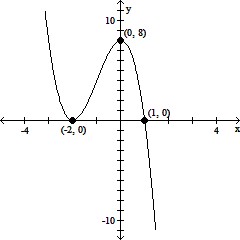Find a polynomial function f(x) of least possible degree having the graph shown.
A. f(x) = 2(x + 2)2(x - 1)
B. f(x) = 2(x - 2)2(x + 1)
C. f(x) = -2(x - 2)2(x + 1)
D. f(x) = -2(x + 2)2(x - 1)
Answer: D
You might also like to view...
Solve the problem. Round to the nearest tenth if necessary.Scott set up a volleyball net in his backyard. One of the poles, which forms a right angle with the ground, is 7 feet high. To secure the pole, he attached a rope from the top of the pole to a stake 10 feet from the bottom of the pole. To the nearest tenth of a foot, find the length of the rope.
A. 12.2 ft B. 7.1 ft C. 149 ft D. 4.1 ft
Provide an appropriate response.Does knowing that  ? 1 tell you anything about
? 1 tell you anything about  Give reasons for your answer.
Give reasons for your answer.
What will be an ideal response?
Solve the problem.The instantaneous growth rate of a population is the rate at which it is growing at every instant in time. The instantaneous growth rate r of a colony of bacteria t hours after the start of an experiment is given by the function  for
for  Find the times for which the instantaneous growth rate is zero.
Find the times for which the instantaneous growth rate is zero.
A. 1 sec and 2 sec B. 1 sec C. 1 sec, 2 sec, and 4 sec D. 2 sec and 4 sec
Solve the problem involving consecutive integers.In a recent International Gymnastics competition, the U.S., China, and Romania were the big winners. If the total number of medals won by each team are three consecutive integers whose sum is 69 and the U.S. won more than China who won more than Romania, how many medals did each team win?
A. U.S.: 25 medals; China: 24 medals; Romania: 23 medals B. U.S.: 71 medals; China: 70 medals; Romania: 69 medals C. U.S.: 24 medals; China: 23 medals; Romania: 22 medals D. U.S.: 22 medals; China: 21 medals; Romania: 20 medals